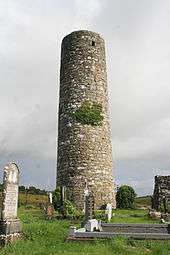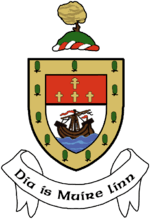Aughagower
| Aughagower Achadh Ghobhair | |
|---|---|
| Town | |
 Aughagower Location in Ireland | |
| Coordinates: 53°45′49″N 9°27′50″W / 53.7635°N 9.464°WCoordinates: 53°45′49″N 9°27′50″W / 53.7635°N 9.464°W | |
| Country | Ireland |
| Province | Connacht |
| County | County Mayo |
| Elevation | 157 m (515 ft) |
| Population (2002) | |
| • Urban | 875 |
| Time zone | UTC+0 (WET) |
| • Summer (DST) | UTC-1 (IST (WEST)) |
| Irish Grid Reference | M034803 |
Aughagower or Aghagower (Irish: Achadh Fhobhair, meaning "Field of the Springs") is a tiny village in rural County Mayo in western Ireland. It is located about 6 km from Westport. Aughagower has around 40 houses and 2 pubs, with a clear view of Croagh Patrick. It also forms the centre of a parish of the same name which covers an area of 86.1 square miles[1]. The village is primarily known today for its ancient and cultural history, as well as its links to St. Patrick and Tóchar Phádraig, the pilgrimage route from Ballintubber Abbey to Croagh Patrick.
St. Patrick is recorded as having stayed in Aughagower where he built a church and anointed the parish's first bishop, Senach, on his journey to Croagh Patrick. Aughagower lies mid-way along Tóchar Phádraig, formerly a part of the royal processional route from Cruachan (the ancient capital of Connacht), and later an important pilgrimage route from Ballintubber Abbey to Croagh Patrick. Senach founded a church, and his daughter Mathona, a nunnery. These were situated appromixately 100 yards north of the medieval round tower and abbey.[2]
Round tower and Abbey

The ruins of a medieval church adjoins the graveyard of the town's modern Catholic church. It has a well-preserved tenth-century Irish round tower, with the exception of its topmost section and capstone.
The tower was built between 973 and 1013[3], a period during which the round tower proliferated, wherein they provided a defensive vantage point, a place of safety for church riches and fortification against raids from the north by the Danish, Norse-Gaels and raiding Irish clans. [4] According to legend, the round tower's capstone was struck by lightning, and landed half a mile away on the hill of Tavenish. A local woman is said to have carried the heavy cap stone in her apron to the church, where it still remains today[3] The tower was partly restored in 1969 and leans slightly to the north.[3]
Ancient monuments
There are a number of ancient monuments in Aughagower, some of which are locally believed to trace their origin to the time of St. Patrick's ministry in the parish.
Leaba Phádraig (Patrick's bed) is said to have been a place where St. Patrick rested, which a local historian has suggested may have housed a hut or tent, used in the daytime as place of work.[5]
Dabhach Phádraig (Patrick's vat or tub) is a circular bath surrounded by a stone wall, where pilgrims may have washed their feet, and which may have been used by St. Patrick and his household as a washing place. Due to local drainage the well is now dry except in extremely wet weather. A local man discovered a sheela na gig (Irish: Sighle na gCíoch) in a nearby ditch, in 2017, and it now forms part of Dabhach Phádraig's eastern wall. [6]
Tobair na Deocháin (the well of the deacons), now dried up, was where pilgrims drank water while performing the pilgrimage. A tree growing over Dabhach Phádraig was said to have curative powers. The soil was applied in a poultice, and when the ailment was cured the soil must be returned.
Cloughundra. There is a large stone of approximately 150kg, named Cloughundra, which is currently on display on the village green. The local folk-tale states that there was once a giant in Aughagower who used to throw the stone over his shoulder and would throw it "as far as another man would send a pebble. The stone is there yet and the trace of his fingers in it. A great many strongmen spend their leisure time trying to lift the stone". [7].
Leacht Tomaltaigh is an ancient monument on the Gorteen-Aughagower townland boundary, just south of where the Tóchar Phádraig passes. Its mythical origin relates to a tale from St. Patrick's time, that a man tested the claims of the generosity of St. Patrick's household, where nobody in need of food would be turned away. The housekeeper is said to have told himthat there was a cake in the oven, and that when it was baked he could have some. He pretended to be angry and left saying the claims of hospitality were untrue, after a few hundred yards he fell from his horse to his death and a monument was raised to mark the spot of his death. The explanation of the myth is unlikely for a number of reasons and it is thought that this monument marks the grave of one of St. Patrick's charioteers, Totmael ('bald poll') who is recorded in the Book of Armagh and The Tripartite Life of St. Patrick as having died whilst St. Patrick and his household were travelling to Croagh Patrick, along the Tóchar. [8]
History
Aughagower came to prominence in 441 when St. Patrick founded a church and bishopic, and placed over it Bishop Senach; the Book of Armagh states that bishops dwelt there in the time of the writer (early part of the ninth century).[9] Senach was a local pagan chieftain, one of St. Patrick's first converts in Aughagower, with whom St. Patrick lived when in Aughagower.
Since its formation by St. Patrick as a bishopric in the 5th century, Aughagower represented one of the most populous and influential parishes in Umhaill. The jurisdiction of Aughagower extended over the "Owles", the territory around Clew Bay, comprising the modern deanery of Westport. But after several centuries these churches and their lands were absorbed first into the Diocese of Mayo and afterwards granted to the Archbishop of Tuam.
The importance of the parish was still evident six centuries after St. Patrick departed, as seen when in 1215 competing claims by the Archbishops of Tuam and Armagh to the church and lands of Aughagower arose, with Pope Innocent in Rome having to settle the dispute in favour of Tuam.[10].
In the 15th and 16th centuries Umhaill and Aughagower saw intense internecine struggles between warring clans and the Tudor Kingdom of Ireland, led by Sir Richard Bingham who sought to establish control of the area, forcing local clans such as the Bourke clan to submit their titles and claims of land to the monarchy, and swear allegiance to the crown, after which their lands would be re-granted to them for their loyalty. [11].
The importance of Aughagower parish in these warring episodes is seen by the defensive forts of Doon Castle and MacPhilbin's castle in Ayle (ruins of which are still standing), which were controlled by the MacPhilbin (also rendered as McPhilipin) clan, a scion of the powerful Bourke family, descending from Philip, brother of William Liath de Burgo (Bourke). The Bourkes initially battled fiercely with the Kindgdom of Ireland forces, but in later centuries became part of the Anglo-Irish ascendancy.
A great part of the population of the parish of Aughagower was lost in the Great Famine, and traces of ruins of deserted houses exist in several parts of the parish.[12].
The Carrowkennedy ambush took place in Carrowkennedy, in the south of Aughagower parish. One of the few encounters of the Irish War of Independence to take place in County Mayo, the Carrowkennedy ambush was carried out by the Irish Republican Army (IRA) on 2 June 1921, during the Irish War of Independence. An IRA flying column, commanded by Michael Kilroy, ambushed a mobile patrol of the Royal Irish Constabulary Special Reserves (Black and Tans) at Carrowkennedy, near Westport, County Mayo. It resulted in the deaths of eight of the RIC, including some who were killed by their own rifle grenade. After two hours the RIC surrendered and their weaponry and ammunition were seized by the IRA.[13] The RIC prisoners were not executed, but released upon their surrender, and this led many members of the successful ambush to seek refuge in the network of safe-houses throughout the counties of Mayo and Galway.
References
- ↑ https://www.townlands.ie/mayo/aghagower/
- ↑ John Keville, 'Saints, Chieftains and Landlords' published in three parts in Cathair na Mart Vol.2, no.1, 1982; vol.3, no.1, 1983; vol.4, no, 1984.
- 1 2 3 Tóchar Phádraig A Pilgrims Progress - published by Ballintubber Abbey 1989
- ↑ John Keville, 'Saints, Chieftains and Landlords' published in three parts in Cathair na Mart Vol.2, no.1, 1982; vol.3, no.1, 1983; vol.4, no, 1984.
- ↑ Brian Mannion, 'Aughagower and its Patrician sites and connections' published in 'Cathair na Mart, Journal of the Westport Historical Society, Vol. 8, No.1, 1988, pages 5-19
- ↑ Brian Mannion, 'Aughagower and its Patrician sites and connections' published in 'Cathair na Mart, Journal of the Westport Historical Society, Vol. 8, No.1, 1988, pages 5-19
- ↑ John Keville, 'Cathair na Mart Vol.2, no.1, 1982.
- ↑ Brian Mannion, 'Aughagower and its Patrician sites and connections' published in 'Cathair na Mart, Journal of the Westport Historical Society, Vol. 8, No.1, 1988, pages 5-19
- ↑ http://www.newadvent.org/cathen/15079d.htm Catholic Encyclopaedia 1917
- ↑ Right Rev. Monsignor D'Alton, 'History of the Archdicoese of Tuam', 1928, Chapter V page 82-83
- ↑ Right Rev. Monsignor D'Alton, 'History of the Archdicoese of Tuam', 1928,
- ↑ John Keville, 'Aughagower Part 3', Cathair na Mart Volume 4 page 28, 1984
- ↑ https://en.wikipedia.org/wiki/Carrowkennedy_ambush
| Wikimedia Commons has media related to Aghagower. |
c
